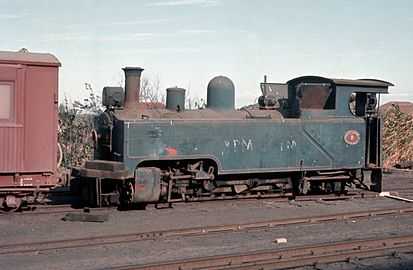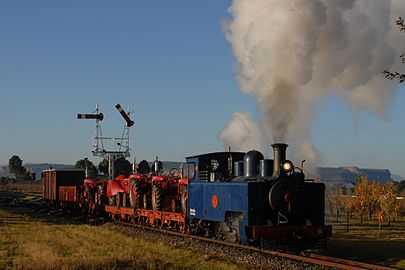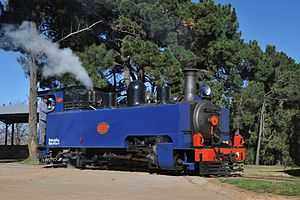South African Class NG4 4-6-2T
| South African Class NG4 4-6-2T ex NGR Class N 4-6-2T 1911 | |
|---|---|
|
No. NG16, restored at Sandstone Estates, 4 May 2013 | |
| Type and origin | |
| Power type | Steam |
| Designer | Natal Government Railways |
| Builder | Kerr, Stuart and Company |
| Serial number | 1207-1208, 1294-1295, 1342-1344 |
| Model | Kerr Stuart Side Tank |
| Build date | 1911-1914 [1] |
| Total produced | 7 |
| Specifications | |
| Configuration | 4-6-2T "Pacific" |
| Gauge | 2 ft (610 mm) narrow gauge |
| Leading wheel diameter | 18 in (457 mm) |
| Driver diameter | 30 in (762 mm) |
| Trailing wheel diameter | 21 in (533 mm) |
| Wheelbase |
17 ft 9 in (5.410 m) total 3 ft 6 in (1.067 m) pilot 5 ft 9 in (1.753 m) coupled |
| Length | 24 ft 11 in (7.595 m) |
| Height | 9 ft 4.5 in (2.858 m) |
| Frame | Plate frame |
| Axle load | 6.15 long tons (6.2 t) on 2nd driver |
| Weight on drivers | 18.2 long tons (18.5 t) |
| Locomotive weight |
51,296 lb (23.3 t) empty 29.7 long tons (30.2 t) w/o |
| Fuel type | Coal |
| Fuel capacity | 21.5 long cwt (1,092.250 kg) |
| Water capacity | 820 imp gal (3,700 l) |
| Boiler |
3 ft 3.5 in (1.003 m) inside diameter 11 ft 2.125 in (3.407 m) inside length 4 ft 9 in (1.448 m) pitch |
| Boiler pressure | 165 psi (1,140 kPa) |
| Firegrate area | 11 sq ft (1.022 m2) |
| Heating surface: – Tubes |
128 tubes 1.75 in (44.4 mm) diameter 655.4 sq ft (60.889 m2) |
| – Firebox | 45.5 sq ft (4.227 m2) |
| – Total | 700.9 sq ft (65.116 m2) |
| Cylinders | Two |
| Cylinder size |
11.5 in (292 mm) bore 15 in (381 mm) stroke |
| Valve gear | Walschaerts |
| Performance figures | |
| Tractive effort | 8,183 lbf (36 kN) at 75% pressure |
| Career | |
| Operator(s) |
Natal Government Railways South African Railways [2] |
| Class | Class NG4 |
| Number in class | 7 |
| Number(s) |
NGR no. 10-11 SAR no. NG10-NG16 |
| Delivered | 1911-1914 |
| First run | 1911 |
| Withdrawn | 1948 [3] |
The South African Class NG4 4-6-2T of 1911 is a South African steam locomotive from the pre-Union era in the Natal Colony.
In 1911, shortly before being amalgamated into the South African Railways, the Natal Government Railways placed the first two of seven 4-6-2T Pacific narrow gauge tank steam locomotives in service. In 1912, when these two locomotives were assimilated into the South African Railways, they retained their engine numbers but with an "NG" prefix added.[3]
Five more of these locomotives were delivered to the South African Railways in 1913 and 1914. When a system of grouping narrow gauge locomotives into classes was eventually introduced somewhere between 1928 and 1930, they were all classified as Class NG4.[3]
Manufacturers
Like their two predecessors, the Hunslet Side Tank and the Hawthorn Leslie Side Tank 4-6-2T locomotives, the third batch of narrow gauge 4-6-2T Pacific tank locomotives of the Natal Government Railways (NGR) were also built to the design of NGR Locomotive Superintendent D.A. Hendrie, but using the Hawthorn Leslie drawings for the Class NG3.[1]
Between 1911 and 1913 the High Commissioner for the Union of South Africa placed three orders for altogether seven of these locomotives with Kerr, Stuart and Company.
- Two locomotives were ordered on 10 January 1911 and were dispatched from the factory in September of that same year with Kerr, Stuart works numbers 1207 and 1208, for delivery to the Natal Government Railways. They were numbered NGR 10 and 11 and designated Class N.[4]
- Two more were ordered on 28 September 1912 and were dispatched from the factory in April and May 1913 for delivery to the South African Railways (SAR), with works numbers 1294 and 1295. They were numbered SAR NG12 and NG13.[4]
- Three more were ordered on 10 June 1913 and dispatched from the factory in July 1914, with works numbers 1342 to 1344. They were numbered SAR NG14 to NG16.[4] This last order also included the final two of the Class NG8 4-6-0 tender locomotives that were delivered with Kerr, Stuart works numbers 1345 and 1346.[1][3][5]
Characteristics
These locomotives were virtually identical to the Hawthorn Leslie Side Tanks, except for their boiler design. The boiler pitch had been raised from 4 feet 6 inches (1.372 metres) to 4 feet 9 inches (1.448 metres) to make a larger firebox possible. They had outside plate frames, Belpaire fireboxes and used Walschaerts valve gear.[1][3]
The most obvious visual differences from the Hawthorn Leslie locomotives were the higher side tanks and the less ornate sand boxes on top of the boiler. As built they had no headlamps, but some were later equipped with the large oil headlamps that were in use on the SAR at the time.[6]
Classification
The Union of South Africa was established on 31 May 1910, in terms of the South Africa Act, enacted by the Parliament of the United Kingdom. One of the clauses in the Act required that the three Colonial Government railways, the Cape Government Railways, the NGR and the Central South African Railways, also be united under one single administration to control and administer the railways, ports and harbours of the Union. While the SAR came into existence in 1910, the actual classification and renumbering of all the rolling stock of the three constituent railways required careful planning and was only implemented with effect from 1 January 1912.[5][7]
In 1912 narrow gauge locomotives were included in the SAR’s narrow gauge numbering scheme and were allocated engine numbers with an "NG" prefix. The two locomotives delivered in 1911, listed as "Late Administration S.A.R. numbers 10 and 11" in the renumbering lists, were therefore renumbered NG10 and NG11.[5]
The system of grouping SAR narrow gauge locomotives into classes was only adopted somewhere between 1928 and 1930 and at that point these seven locomotives were designated Class NG4.[2][3][5]
Service
Railways
The Class NG4 was placed in service on the Alfred County Railway, of which the first section was opened on 8 November 1911, to work from Port Shepstone on the Natal South Coast to Harding. All but one remained working on the Natal narrow gauge branches for their entire service lives. The one exception, number NG12, was sent to German South West Africa in 1914 as part of the war effort during World War I, but it was returned to Natal in 1916.[1][3][6]
Industrial
Number NG11 was sold to the Savane Sawmills of Rhodesian Timber Concessions in 1942. The last one to remain in service, number NG16, was sold to the Rustenburg Platinum Mines (RPM) in 1948, where it was renumbered to RPM number 8.[1][3][6]
Preservation
Number NG16 is the only known survivor. RPM returned it to the SAR for preservation in 1969 or 1970, but it was only restored back to working order after Sandstone Estates acquired it on 31 January 2003.
Sides illustrated
The main picture and the following illustrate the two sides of the Class NG4 locomotive.
-
.jpg)
Kerr, Stuart and Company builder’s picture of no. NG10, works no. 1207
-
.jpg)
SAR Class NG4 no. NG16
-

No. NG16, RPM no. 8, at Port Shepstone, 17 April 1970
-

No. NG16, at work at Sandstone Estates, 22 April 2007
See also
- List of South African locomotive classes
- Narrow Gauge locomotive numbering and classification
- NGR Class N 4-6-2T 1906
- South African Class NG3 4-6-2T
- South African locomotive history
- The 4-6-2 "Pacific"
- Two foot gauge railways in South Africa
References
|
- ↑ 1.0 1.1 1.2 1.3 1.4 1.5 Plant, K.P. (1971). Kerr Stuarts for South Africa. The Industrial Railway Record, No. 37, June 1971. pp. 78-85.
- ↑ 2.0 2.1 South African Railways and Harbours Narrow Gauge Locomotive Diagram Book, 2’0” Gauge, S.A.R. Mechanical Dept. Drawing Office, Pretoria, 28 November 1932
- ↑ 3.0 3.1 3.2 3.3 3.4 3.5 3.6 3.7 Paxton, Leith; Bourne, David (1985). Locomotives of the South African Railways (1st ed.). Cape Town: Struik. pp. 101–102, 110. ISBN 0869772112.
- ↑ 4.0 4.1 4.2 Jux, Frank (1991). Kerr Stuart & Co. Ld. – Locomotive Works List (1st ed.). England: Frank Jux.
- ↑ 5.0 5.1 5.2 5.3 Classification of S.A.R. Engines with Renumbering Lists, issued by the Chief Mechanical Engineer’s Office, Pretoria, January 1912, pp. 16, 47 (Reprinted in April 1987 by SATS Museum, R.3125-6/9/11-1000)
- ↑ 6.0 6.1 6.2 Railway Modelling Scene, South Africa, circa 1985, articles written by Neill Mardell
- ↑ The South African Railways - Historical Survey. Editor George Hart, Publisher Bill Hart, Sponsored by Dorbyl Ltd., Published c. 1978, p. 25.
